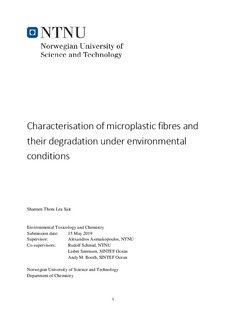| dc.description.abstract | Despite evidence that microplastic fibres (MPFs) make up the largest proportion of microplastic pollution in aquatic environments, little is known about their degradative fate. This study investigated the UV and mechanical degradation of common MPFs: Polyester (PET), polyamide (PA) and polyacrylonitrile (PAN). Additionally, wool was included in some studies as a natural reference fibre. The characterisation of organic and inorganic additive content in the MPFs and wool, together with additive leaching was also investigated. Black and white PET, white PA, blue and orange PAN reference materials were subject to accelerated UV irradiation in seawater and freshwater media over 9 months at 65 W/m2, representing the maximum UV exposure found globally. PET and PA MPFs showed significant fragmentation and changes in surface morphology after UV exposure. In contrast PAN did not show significant degradation under the same exposure conditions. Changes in chemical bond structures (carbonyl groups) were measured via Attenuated total reflectance-Fourier transform infrared spectroscopy (ATR-FTIR). PA showed an increase in the carbonyl index over time, while PET and PAN exhibited no observable trend in relation to carbonyl indices. The potential for mechanical degradation of pristine MPFs and wool was also assessed at 20 and 5 °C in the presence of seawater and sand. No fragmentation of any material was observed at either exposure temperature after 9 months.
Chemical additives in MPFs, and the leaching of chemical additives and polymer degradation products into freshwater and seawater was explored. A non-target approach using gas chromatography coupled to mass spectrometry (GC-MS) was first employed. The majority of the chromatographically resolved compounds could either not be identified in the NIST library or characterised based on their compound origin. Detailed investigation of the content of several bisphenols (BPs) and benzophenones (BzPs), typically employed as UV-stabilisers in MPFs and leachates, was performed via liquid chromatography coupled to tandem mass spectrometry (LC-MS/MS). BPA, BPS and BzP3 were present in all MPF samples at concentrations ranging from 4.3 - 501 ng/g, with coloured MPFs showing a higher proportion of BPs. Wool displayed the greatest total BP and BzP content at 863 and 27 ng/g, respectively. There was no detectable leaching of BPs and BzPs into water (in 14 day, and 5- and 9-month). In a final step, the targeted analysis of a broad range of known antioxidants, UV and processing stabilisers using GC-MS was conducted. All target compounds were below detectable levels in MPFs and wool. Metal content was characterised in MPFs and wool, with wool containing the highest concentration of most metals. Leaching studies conducted in seawater and freshwater media at 20 and 5 °C exhibited high levels of metal contamination, including in control samples, meaning no conclusions could be drawn about their leaching potential. The results of the current study strongly suggest that the ultimate fate and potential for detrimental effects of MPFs released to the environment are influenced significantly by multiple factors, including environmental parameters and material-specific properties. While more research is needed, the research conducted indicates that synthetic fibres may not pose a greater threat to the environment than natural fibres. | |
